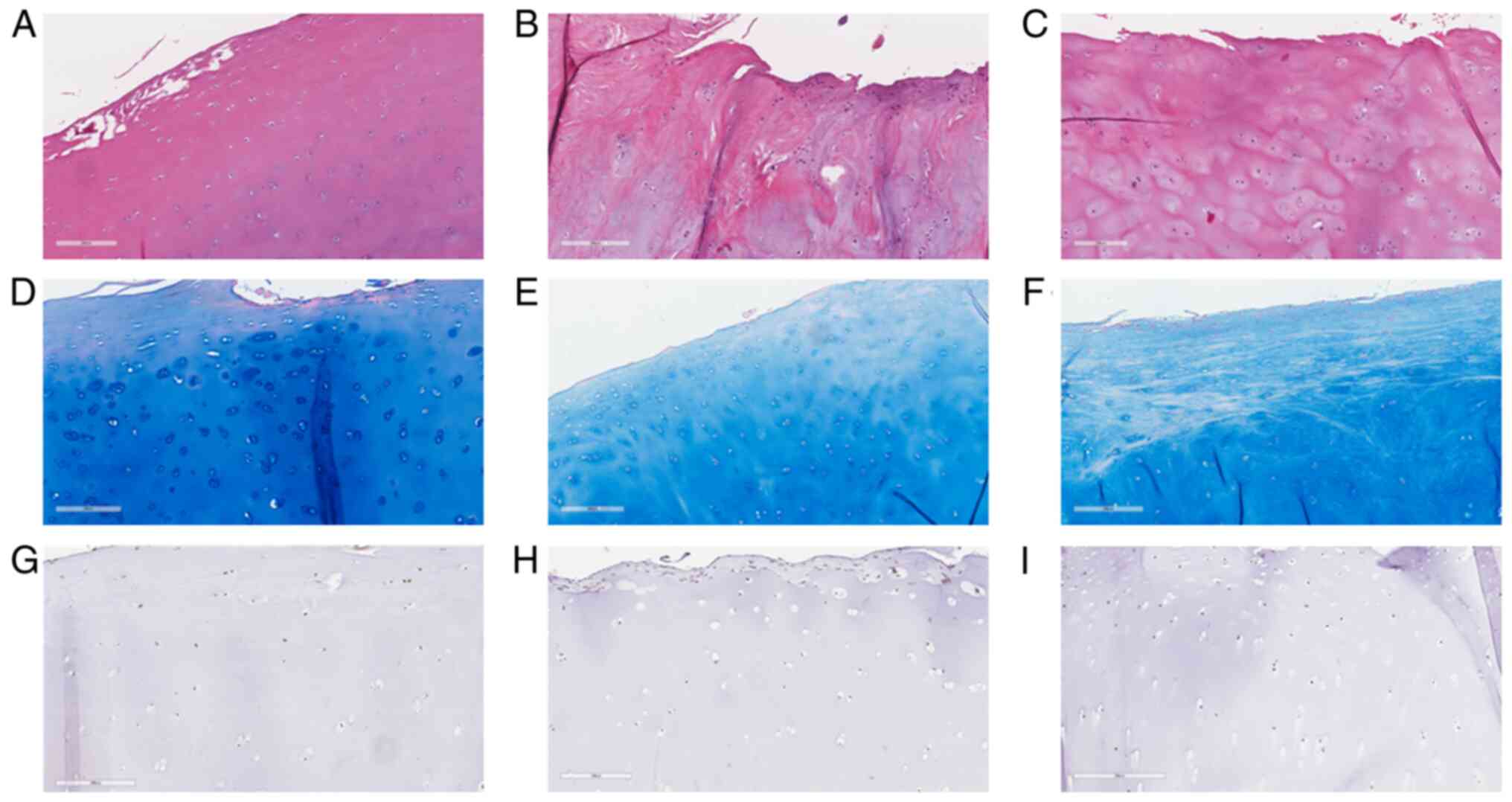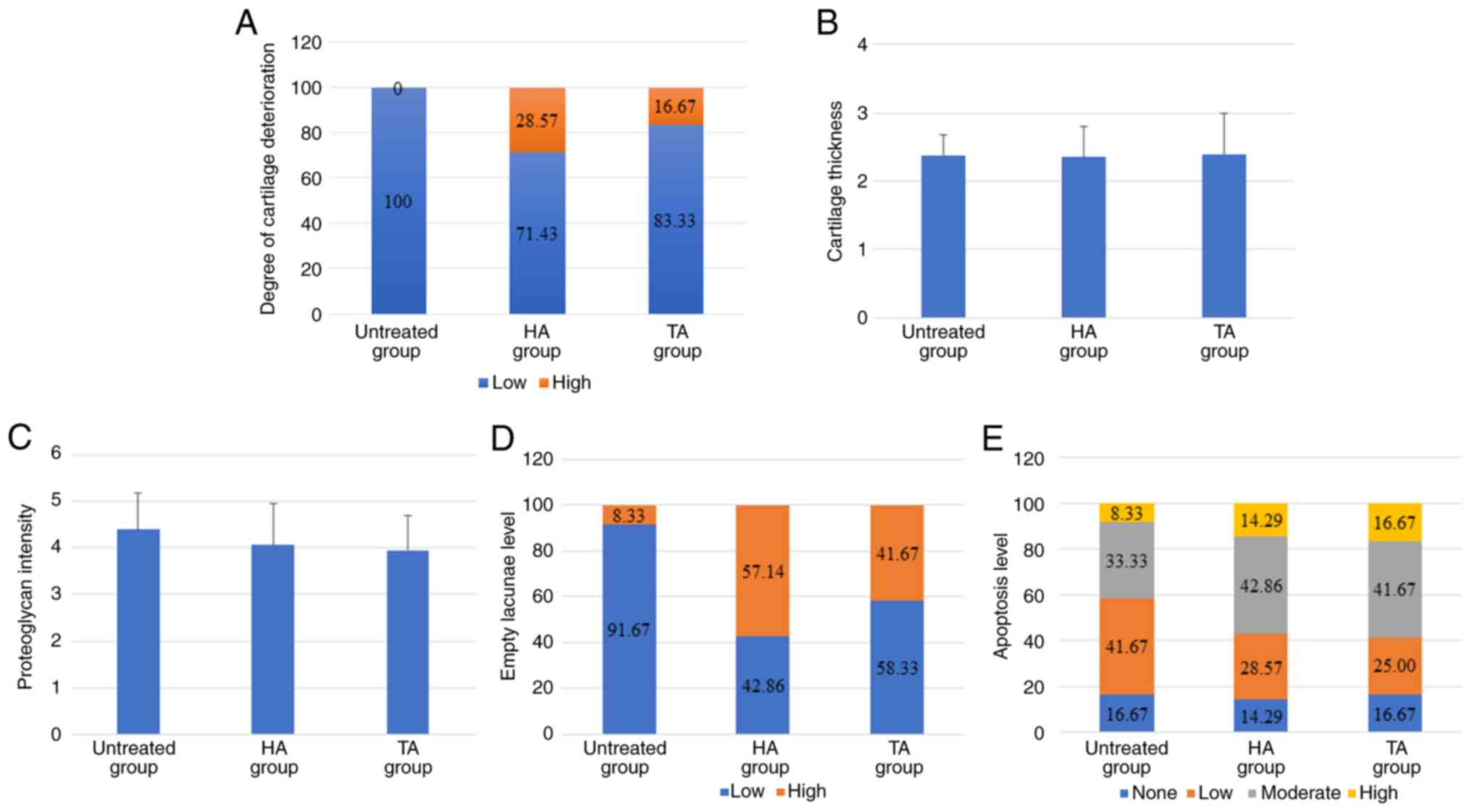|
1
|
Plotnikoff R, Karunamuni N, Lytvyak E,
Penfold C, Schopflocher D, Imayama I, Johnson ST and Raine K:
Osteoarthritis prevalence and modifiable factors: A population
study. BMC Public Health. 15(1195)2015.PubMed/NCBI View Article : Google Scholar
|
|
2
|
Braun HJ and Gold GE: Diagnosis of
Osteoarthritis: Imaging. Bone. 51:278–288. 2012.PubMed/NCBI View Article : Google Scholar
|
|
3
|
Sinusas K: Osteoarthritis: Diagnosis and
treatment. Am Fam Physician. 85:49–56. 2012.PubMed/NCBI
|
|
4
|
Sulzbacher I: Osteoarthritis: Histology
and pathogenesis. Wien Med Wochenschr. 163:212–219. 2013.PubMed/NCBI View Article : Google Scholar
|
|
5
|
Das SK and Farooqi A: Osteoarthritis. Best
Pract Res Clin Rheumatol. 22:657–675. 2008.PubMed/NCBI View Article : Google Scholar
|
|
6
|
Arya RK and Jain V: Osteoarthritis of the
knee joint: An overview. Indian Acad Clin Med. 14:154–162.
2013.
|
|
7
|
Ringdahl E and Pandit S: Treatment of knee
osteoarthritis. Am Fam Physician. 83:1287–1292. 2011.PubMed/NCBI
|
|
8
|
Neustadt DH: Intra-articular injections
for osteoarthritis of the knee. Cleve Clin J Med. 73:897–898.
901–904. 906–911. 2006.PubMed/NCBI View Article : Google Scholar
|
|
9
|
Nguyen C and Rannou F: The safety of intra
articular injections for the treatment of knee osteoarthritis: A
critical narrative review. Expert Opin Drug Saf. 16:897–902.
2017.PubMed/NCBI View Article : Google Scholar
|
|
10
|
Raynauld JP, Buckland-Wright C, Ward R,
Choquette D, Haraoui B, Martel-Pelletier J, Uthman I, Khy V,
Tremblay JL, Bertrand C and Pelletier JP: Safety and efficacy of
long-term intraarticular steroid injections in osteoarthritis of
the knee A randomized, double-blind, placebo-controlled trial.
Arthritis Rheum. 48:370–377. 2003.PubMed/NCBI View Article : Google Scholar
|
|
11
|
Takagi S and Blaha JD: The suitable use of
intra-articular corticosteroid injection in knee osteoarthritis.
Osteoarthritis and Cartilage. 26 (Suppl 1)(S291)2018.
|
|
12
|
Creamer P: Intra-articular corticosteroid
injections in osteoarthritis: Do they work and if so, how? Ann
Rheum Dis. 56:634–636. 1997.PubMed/NCBI View Article : Google Scholar
|
|
13
|
Gibson T, Burry HC, Poswillo D and Glass
J: Effect of intra-articular corticosteroid injections on primate
cartilage. Ann Rheum Dis. 36:74–79. 1976.PubMed/NCBI View Article : Google Scholar
|
|
14
|
Syed HM, Green L, Bianski B, Jobe CM and
Wongworawat MD: Bupivacaine and triamcinolone may be toxic to human
chondrocytes: A pilot study. Clin Orthop Relat Res. 469:2941–2947.
2011.PubMed/NCBI View Article : Google Scholar
|
|
15
|
Chu CR, Coyle CH, Chu CT, Szczodry M,
Seshadri V, Karpie JC, Cieslak KM and Pringle EK: In vivo effects
of single intra-articular injection of 0.5% bupivacaine on
articular cartilage. J Bone Joint Surg Am. 92:599–608.
2010.PubMed/NCBI View Article : Google Scholar
|
|
16
|
Nakazawa F, Matsuno H, Yudoh K, Watanabe
Y, Katayama R and Kimura T: Corticosteroid treatment induces
chondrocyte apoptosis in an experimental arthritis model and in
chondrocyte cultures. Clin Exp Rheumatol. 20:773–781.
2002.PubMed/NCBI
|
|
17
|
Farkas B, Kvell K, Czompoly T, Illes T and
Bardos T: Increased chondrocyte death after steroid and local
anesthetic combination. Clin Orthop Relat Res. 468:3112–3120.
2010.PubMed/NCBI View Article : Google Scholar
|
|
18
|
Suntiparpluacha M, Tammachote N and
Tammachote R: Triamcinolone acetonide reduces viability, induces
oxidative stress, and alters gene expressions of human
chondrocytes. Eur Rev Med Pharmacol Sci. 20:4985–4992.
2016.PubMed/NCBI
|
|
19
|
Stove J, Schöniger R, Huch K, Brenner R,
Günther KP, Puhl W and Scharf HP: Effects of dexamethasone on
proteoglycan content and gene expression of IL-1beta-stimulated
osteoarthrotic chondrocytes in vitro. Acta Orthop Scand.
73:562–567. 2002.PubMed/NCBI View Article : Google Scholar
|
|
20
|
Pelletier JP, Raynauld JP, Abram F, Dorais
M, Paiement P and Martel-Pelletier J: Intra-articular
corticosteroid knee injection induces a reduction in meniscal
thickness with no treatment effect on cartilage volume: A
case-control study. Sci Rep. 10(13789)2020.PubMed/NCBI View Article : Google Scholar
|
|
21
|
Uthman I, Raynauld JP and Haraoui B:
Intra-articular therapy in osteoarthritis. Postgrad Med J.
79:449–453. 2003.PubMed/NCBI View Article : Google Scholar
|
|
22
|
Siebelt M, Korthagen N, Wei W, Groen H,
Bastiaansen-Jenniskens Y, Müller C, Waarsing JH, de Jong M and
Weinans H: Triamcinolone acetonide activates an anti-inflammatory
and folate receptor-positive macrophage that prevents osteophytosis
in vivo. Arthritis Res Ther. 17(352)2015.PubMed/NCBI View Article : Google Scholar
|
|
23
|
Euppayo T, Siengdee P, Buddhachat K,
Pradit W, Chomdej S, Ongchai S and Nganvongpanit K: In vitro
effects of triamcinolone acetonide and in combination with
hyaluronan on canine normal and spontaneous osteoarthritis
articular cartilage. In Vitro Cell Dev Biol Anim. 52:723–735.
2016.PubMed/NCBI View Article : Google Scholar
|
|
24
|
Suntiparpluacha M, Tammachote N and
Tammachote R: Triamcinolone acetonide alters expressions of matrix
metalloproteinase-3 gene in primary human chondrocytes. Genomics
and Genetics. 9:66–71. 2016.
|
|
25
|
Altman RD, Manjoo A, Fierlinger A, Niazi F
and Nicholls M: The mechanism of action for hyaluronic acid
treatment in the osteoarthritic knee: A systematic review. BMC
Musculoskelet Disord. 16(321)2015.PubMed/NCBI View Article : Google Scholar
|
|
26
|
Necas J, Bartosikova L, Brauner P and
Kolar J: Hyaluronic acid (hyaluronan): A review. Veterinarni
Medicina. 53:397–411. 2008.
|
|
27
|
Moreland LW: Intra-articular hyaluronan
(hyaluronic acid) and hylans for the treatment of osteoarthritis:
Mechanisms of action. Arthritis Res Ther. 5:54–67. 2003.PubMed/NCBI View
Article : Google Scholar
|
|
28
|
Neustadt D, Caldwell J, Bell M, Wade J and
Gimbel J: Clinical effects of intraarticular injection of high
molecular weight hyaluronan (Orthovisc) in osteoarthritis of the
knee: A randomized, controlled, multicenter trial. J Rheumatol.
32:1928–1936. 2005.PubMed/NCBI
|
|
29
|
Diracoglu D, Vural M, Baskent A, Dikici F
and Aksoy C: The effect of viscosupplementation on neuromuscular
control of the knee in patients with osteoarthritis. J Back
Musculoskelet Rehabil. 22:1–9. 2009.PubMed/NCBI View Article : Google Scholar
|
|
30
|
Day R, Brooks P, Conaghan PG and Petersen
M: Multicenter Trial Group. A double blind, randomized,
multicenter, parallel group study of the effectiveness and
tolerance of intraarticular hyaluronan in osteoarthritis of the
knee. J Rheumatol. 31:775–782. 2004.PubMed/NCBI
|
|
31
|
Trigkilidas D and Anand A: The
effectiveness of hyaluronic acid intra-articular injections in
managing osteoarthritic knee pain. Ann R Coll Surg Engl.
95:545–551. 2013.PubMed/NCBI View Article : Google Scholar
|
|
32
|
Leopold SS, Redd BB, Warme WJ, Wehrle PA,
Pettis PD and Shott S: Corticosteroid compared with hyaluronic acid
injections for the treatment of osteoarthritis of the knee. A
prospective, randomized trial. J Bone Joint Surg Am. 85:1197–1203.
2003.PubMed/NCBI View Article : Google Scholar
|
|
33
|
Jones AC, Pattrick M, Doherty S and
Doherty M: Intra-articular hyaluronic acid compared to
intra-articular triamcinolone hexacetonide in inflammatory knee
osteoarthritis. Osteoarthritis Cartilage. 3:269–273.
1995.PubMed/NCBI View Article : Google Scholar
|
|
34
|
Abedi M, Kamkar P, Afshari M and Mirkazemi
M: Comparison of the effectiveness of intra-articular injections of
hyaluronic acid and corticosteroid in the treatment of patients
with knee osteoarthritis symptomse. Ortho & Rheum Open Access
J. 7(555704)2017.
|
|
35
|
Kohn MD, Sassoon AA and Fernando ND:
Classifications in Brief: Kellgren-Lawrence classification of
osteoarthritis. Clin Orthop Relat Res. 474:1886–1893.
2016.PubMed/NCBI View Article : Google Scholar
|
|
36
|
Charnwichai P, Kitkumthorn N,
Ruangvejvorachai P, Wongphoom J, Meesakul T, Tammachote N and
Tammachote R: Rapid decalcification of articular cartilage and
subchondral bone using an ultrasonic cleaner with EDTA. Acta
Histochem. 125(152009)2023.PubMed/NCBI View Article : Google Scholar
|
|
37
|
Al-Sabaawy HB, Rahawi AM and Al-Mahmood
SS: Standard techniques for formalin-fixed paraffin-embedded
tissue: A Pathologist's perspective. Iraqi J Veter Sci. 35:127–135.
2021.
|
|
38
|
Pritzker KP, Gay S, Jimenez SA, Ostergaard
K, Pelletier JP, Revell PA, Salter D and van den Berg WB:
Osteoarthritis cartilage histopathology: grading and staging.
Osteoarthritis Cartilage. 14:13–29. 2006.PubMed/NCBI View Article : Google Scholar
|
|
39
|
Ayhan E, Kesmezacar H and Akgun I:
Intraarticular injections (corticosteroid,hyaluronic acid,platelet
rich plasma) for the knee osteoarthritis. World J Orthop.
5:351–361. 2014.PubMed/NCBI View Article : Google Scholar
|
|
40
|
Brooks EM, Hu CH, Kingston KA and Matzkin
EG: Corticosteroid Injections: A review of sex-related side
effects. Orthopedics. 40:e211–e215. 2017.PubMed/NCBI View Article : Google Scholar
|
|
41
|
Vaishya R, Pandit R, Agarwal AK and Vijay
V: Intra-articular hyaluronic acid is superior to steroids in knee
osteoarthritis: A comparative, randomized study. J Clin Orthop
Trauma. 8:85–88. 2017.PubMed/NCBI View Article : Google Scholar
|
|
42
|
Migliore A and Granata M: Intra-articular
use of hyaluronic acid in the treatment of osteoarthitis. Clin
Interv Aging. 3:365–369. 2008.PubMed/NCBI View Article : Google Scholar
|
|
43
|
Barreto RB, Sadigursky D, Rezende MU and
Hernandez AJ: Effect of hyaluronic acid on chondrocyte apoptosis.
Acta Ortop Bras. 23:90–93. 2015.PubMed/NCBI View Article : Google Scholar
|
|
44
|
Rudnik-Jansen I, Schrijver K, Woike N,
Tellegen A, Versteeg S, Emans P, Mihov G, Thies J, Eijkelkamp N,
Tryfonidou M and Creemers L: Intra-articular injection of
triamcinolone acetonide releasing biomaterial microspheres inhibits
pain and inflammation in an acute arthritis model. Drug Deliv.
26:226–236. 2019.PubMed/NCBI View Article : Google Scholar
|
|
45
|
Temple-Wong MM, Ren S, Quach P, Hansen BC,
Chen AC, Hasegawa A, D'Lima DD, Koziol J, Masuda KL, Lotz MK and
Sah RL: Hyaluronan concentration and size distribution in human
knee synovial fluid: Variations with age and cartilage
degeneration. Arthritis Res Ther. 18(18)2016.PubMed/NCBI View Article : Google Scholar
|
|
46
|
Ke Y, Jiang W, Xu Y, Chen Y, Zhang Q, Xue
Q, Lin J, Ngai W, Nian G, Fazeli MS, et al: Efficacy and safety of
a single intra-articular injection of 6 ml Hylan G-F 20 compared to
placebo in Chinese patients with symptomatic knee osteoarthritis.
C-SOUND study, a 26-week multicenter double-blind randomized
placebo-controlled trial in China. BMC Musculoskelet Disord.
22(428)2021.PubMed/NCBI View Article : Google Scholar
|
|
47
|
Chevalier X, Jerosch J, Goupille P, van
Dijk N, Luyten FP, Scott DL, Bailleul F and Pavelka K: Single,
intra-articular treatment with 6 ml hylan G-F 20 in patients with
symptomatic primary osteoarthitis of the knee: A randomised,
multicentre, double-blind, placebo controlled trail. Ann Rheum Dis.
69:113–119. 2010.PubMed/NCBI View Article : Google Scholar
|
|
48
|
Chou CW, Lue KH, Lee HS, Lin RC and Lu KH:
Hylan G-F 20 has better pain Relief and cost-effectiveness than
sodium hyaluronate in treating early osteoarthritic knee in Taiwan.
J Formos Med Assoc. 108:663–672. 2009.PubMed/NCBI View Article : Google Scholar
|
|
49
|
Tammachote N, Kanitnate S, Yakumpor T and
Panichkul P: Intra-Articular, Single-Shot Hylan G-F 20 hyaluronic
acid injection compared with corticosteroid in knee osteoarthritis.
A Double-Blind, Randomized Controlled Trial. J Bone Joint Surg Am.
98:885–892. 2016.PubMed/NCBI View Article : Google Scholar
|
|
50
|
Penning LI, de Bie RA and Walenkamp GH:
Subacromial triamcinolone acetonide, hyaluronic acid and saline
injections for shoulder pain an RCT investigating the effectiveness
in the first days. BMC Musculoskelet Disord. 15(352)2014.PubMed/NCBI View Article : Google Scholar
|
|
51
|
Jones RK, Chapman GJ, Findlow AH, Forsythe
L, Parkes MJ, Sultan J and Felson DT: A new approach to prevention
of knee osteoarthritis: Reducing medial load in the contralateral
knee. J Rheumatol. 40:309–315. 2013.PubMed/NCBI View Article : Google Scholar
|
|
52
|
Felson DT, Nevitt MC, Zhang Y, Aliabadi P,
Baumer B, Gale D, Li W, Yu W and Xu L: High prevalence of lateral
knee osteoarthritis in Beijing Chinese compared with framingham
caucasian subjects. Arthritis Rheum. 46:1217–1222. 2002.PubMed/NCBI View Article : Google Scholar
|
|
53
|
Prodromos CC, Andriacchi TP and Galante
JO: A relationship between gait and clinical changes following high
tibial osteotomyit. J Bone Joint Surg Am. 67:1188–1194.
1985.PubMed/NCBI
|
















